(Looking for Pick
Pockets?)
PSIONIC
POWERS
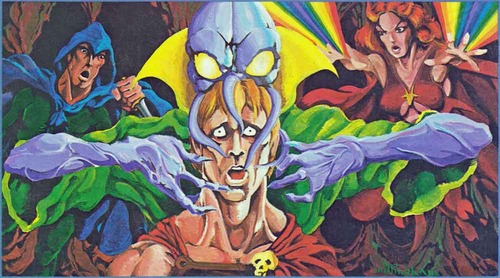
-
(Looking for Pick
Pockets?)
PSIONIC
POWERS

-
|
|
|
|
|
|
|
|
|
|
|
|
|
|
|
|
|
|
|
|
|
|
|
|
|
|
|
|
|
|
Psionic powers include attack
modes,
defense modes,
and disciplines (the magic-like
powers).
The number of each power
is determined by further dice rolls;
attack/defense modes are
selected by choice, disciplines by random selection.
Q: Should a character gain experience points just for using a psionic discipline or attack/defense mode?
A: No.
(78.20)
Attack
Modes:
Roll percentile dice, and
consult the following table:
01-25 1 attack mode
26-50 2 attack modes
51-75 3 attack modes
76-95 4 attack modes
96-00 5 attack modes
| Attack Modes | Point Cost per Usage | Short | Medium | Long | Area of Effect |
| A. Psionic Blast | 20 | 2" | 4" | 6" | 1/2" base ,6" length, 2" terminus cone |
| B. Mind Thrust | 4 | 3" | 6" | 9" | 1 creature |
| C. Ego Whip | 7 | 4" | 8" | 12" | 1 creature |
| D. Id Insinuation | 10 | 6" | 12" | 18" | 2" x 2" area within range |
| E. Psychic Crush* | 14 | 5" | - | - | 1 creature |
* User may use only defense mode G, Thought Shield.
Attacks
in series add 50% to range for each psionic linked, i.e. 2=200%
of
range,
3=250% of range, etc. Expenditure of double or treble points b yan
individual
will double or treble range of attack modes B, C, or D.
Medium range attacks reduce damage by 20%, fractions rounded up.
Long
range attacks reduce the attacker's effective total psionic strength
by
one
category (25 points) and reduce damage by 20%, fractions rounded
up.
If the attacker is already in the 01-25 range, damage is
reduced
50%, fractions being dropped.
SA:
Unless otherwise specified in a particular description,
no
psionic attack mode or discipline can be employed while the user's mind
is distracted or engaged in some other decision-making activity.
Psionic
Blast is a wave of brain force, in effect much like "stunning news"
to the mind.


It is costly in attack point
expenditure, but it is the only psionic attack which can affect non-psionic
creatures.
The attack is a cone-shaped
wave of force 1/2" diameter at its source and 2" diameter at its terminus
(6" distance).
Point Cost per Usage: 20
Range: 2" / 4" / 6"
Area of Effect:
Mind Thrust
is a stabbing attack which seeks to short the synapses of the defender.
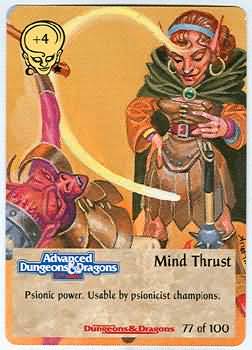
The attack is individual.
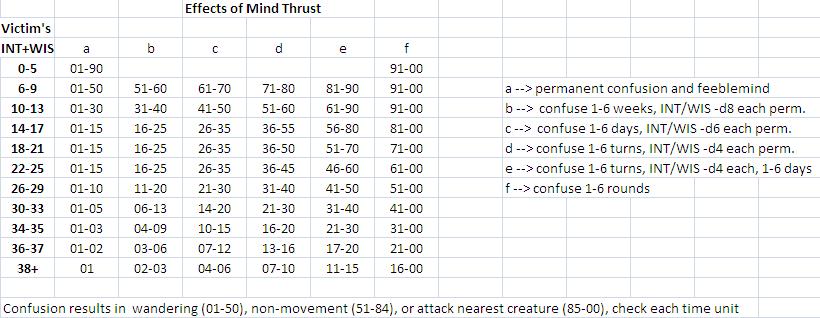
Point Cost per Usage: 4
Range: 3" / 6" / 9"
Area of Effect:
Ego Whip attacks the ego, either by feelings of inferiority and worthlessness or by superiority && megalomania.
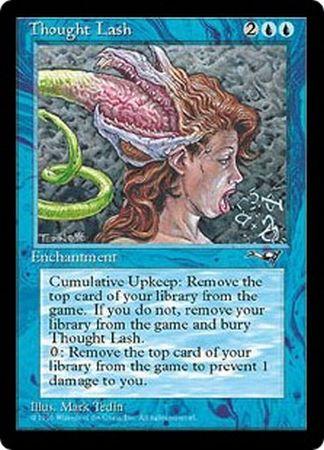
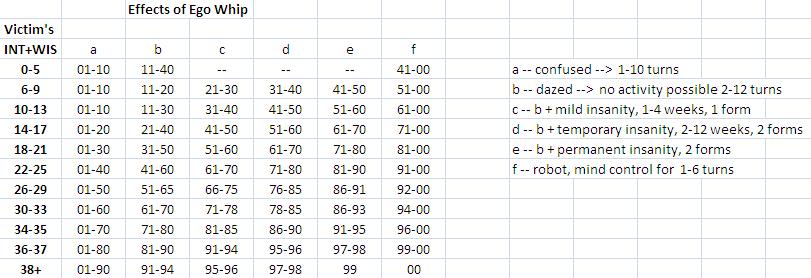
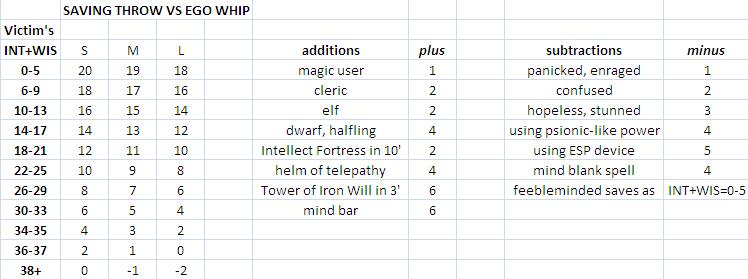
The attack affects but a
single creature.
Point Cost per Usage: 7
Range: 4" / 8" / 12"
Area of Effect:
Id Insinuation seeks to loose the uncontrolled subconscious mind of the defender, pitting it against the super-ego.

The attack affects all psionically
aware creatures in a 2" X 2"area within attack range.
Point Cost per Usage: 10
Range: 6" / 12" / 18"
Area of Effect:
Psychic
Crush is a massive assault upon all neurons in the brain,
attempting to destroy all
by a massive overload of signals.
This mode of attack affects
but one defender.
If it is used the user may
defend with only mode G, Thought Shield, or have no defense at all.
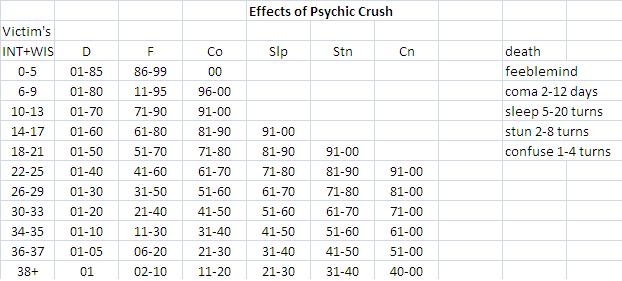
Point Cost per Usage: 14
Range: 5" / - / -
Area of Effect:
Q: If a character
is slain by psychic crush, can he be raised
or resurrected?
Would he still then possess
psionic abilities?
A: The character can
be raised or resurrected, but all psionic abilities will be permanently
lost.
(78.18)
Q: The Players
Handbook states that thought shield is the only
defense against psychic
crush, but the charts in the Dungeon
Masters Guide contradict this.
Why?
A: Anyone who's confused
on this point has misinterpreted the
statement in the PH.
The psionic character employing psychic
crush as his attack mode
can only use a thought shield defense,
or else must have no defense
mode up at all. The character or
creature being attacked
by psychic crush may use any defense
mode at his disposal.
(78.18)
Point Cost per Usage: This shows the number of psionic attack points of strength which the attacker must expend in using the attack mode.
Attack Range: This
table shows the various distances at which the various attack modes will
function.
Effects of attacks are reduced
at medium and long ranges.
If all attack points are
expended, or too few remain to use any attack mode listed, the creature
may defend only.
Defense
Modes:
Roll percentile dice and
consult the following table:
01-25 2 defense modes
26-75 3 defense modes
76-90 4 defense modes
91-00 5 defense modes
| Defense Mode | Point Cost per Usage | Area Protected |
| F. Mind Blank | 1 | Individual only |
| G. Thought Shield | 2 | Individual only |
| H. Mental Barrier | 3 | Individual only |
| I. Intellect Fortress | 8 | 10'r. of individual |
| J. Tower of Iron Will | 10 | 3'r. of individual |
The individual must always have defense mode F. Others are optionally selected.
Mind
Blank attempts to hide the mind from attack, making its parts unidentifiable.
Point Cost per Usage: 1
Area Protected: Individual
only
Thought
Shield cloaks the mind so as to hide first one part, then another.
This defense can be kept
upat all times, unlike the others.
Point Cost per Usage: 2
Area Protected: Individual
only
Q: If a psionic spell
caster has a thought shield defense up while
casting a spell, would a
psionic attack made against the character
cause the spell to be lost,
or would the defense hold and allow
the spell to be cast to
completion?
A: The spell casting
will continue uninterrupted as long as the
thought shield defense holds
out. If a physical attack takes place,
of course, the spell will
be ruined; the same applies if the spell
caster is made subject to
certain disciplines such as telekinesis,
body weaponry, and the like.
If the defender runs out of defense
strength and takes damage
from a psionic attack, this will also
ruin any spell the defender
may have been casting at the time.
(78.18)
Q: What does the Players
Handbook mean when it says that
thought shield can
be kept up at all times, unlike other defenses?
A: Thought shield,
like all psionic defense modes, may be activated
even when there is no psionic
attack in progress against the
'defender'. However, thought
shield is the only defense that
may be used when the character
is engaged in active pursuits like
physical fighting, spell
casting, escaping, etc. Once put into
operation, a thought
shield does not require attention to continue
to be maintained -- but,
by the same token, the user must
specifically declare his
intention to "turn off" the shield when
deactivation is desired;
otherwise, his defense points will keep
dwindling automatically.
(78.18)
Mental
Barrier is a carefully built thought repetition wall which exposes
only that small area.
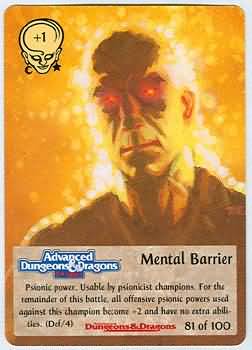
Point Cost per Usage: 3
Area Protected: Individual
only
Intellect
Fortress is a defense which calls forth the powers of the ego and super-ego
to stop attacks.
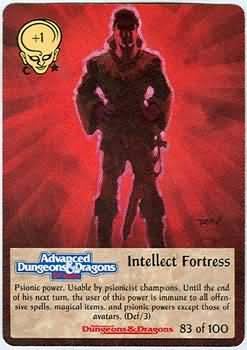
Point Cost per Usage: 8
Area Protected: 10' r. of
individual
Tower
of Iron Will relies only upon the super-ego to build an unassailable
haven for the brain.

Point Cost per Usage: 10
Area Protected: 3' radius
of individual
<check all of the jpg tables>
Point Cost per Usage: This shows the number of psionic defense points of strength which the attacker must expend to use the defense mode when under psionic attack.
Area Protected: If
the defense mode has an area of protection beyond the individual,
it offers its defense, or
the defense used by any individual within its radius, whichever is better.
Suppose 3 psionics are defending
in a group;
the first puts up defense
mode F, another I, and the third puts up J.
The first selects from defense
modes F, I or J; the other two from either I or J,
whichever does the most
efficient job of damage reduction.
Non-psionics in the area
are given +2 by an Intellect Fortress, +6 by a Tower of Iron Will,
on saving throws versus
Psionic Blast.
If all defense points are
expended, the individual has NO defense and can be attacked on a special
combat table which offers the possibility of stunning, mental wounding
or crippling, and death as well as loss of psionic strength points.
PSlONlC DISCIPLINES
The psionically endowed
character determines how many disciplines he or she is able to exercise
by use of the following table (one roll of percentile dice):
| Die Score | Minor | Major |
| 01-10 | 1 | 0 |
| 11-25 | 2 | 0 |
| 26-40 | 3 | 0 |
| 41-55 | 2 | 1 |
| 56-70 | 3 | 1 |
| 71-80 | 4 | 1 |
| 81-90 | 3 | 2 |
| 91-95 | 5 | 1 |
| 96-00 | 4 | 2 |
Once the number of disciplines
possessed is known,
the character determines
by random die rolling which disciplines he or she knows.
If the same one is indicated
a second time, simply re-roll until a different one is indicated.
Only a few ore excluded
to certain classes. Only one discipline (minor) can immediately be gained,
with one additional discipline
(all minor first) gained with the acquisition of each 2 additional levels
of experience in the character's profession.
Note
that the employment of these powers costs
psionic strength points, the equivalent of 1 point each of attack and defense
points.
Q: When a character
acquires a psionic
discipline that uses a level
of
mastery, is the effective
level of
mastery equal to the character?s
current level?
A: No. When a character
first acquires a
discipline, the level of
mastery is level one,
the character?s experience
level notwithstanding.
Thereafter, the level of
mastery
increases each time the
character gains a
new level.
(142.10)
ADQ: What happens
if a psionic hobbit
fighter rolls eligibility
to learn more than
3 disciplines? A 4th discipline
cannot be
gained until 7th level --
a level which
hobbit fighters are incapable
of attaining.
Is the hobbit's psionic
growth
stunted just because he
can no longer
advance as a fighter?
ADA: YES. However,
if you (as DM) wish to
allow it, the next discipline
may be gained
when the character's XP
total indicates that
promotion would have occurred
(though it
does not). This also solves
the problem
of hobbits unable even to
reach 5th level.
<revise with UA>
(Polyhedron #26)
ADQ: Do psionic disciplines come
into
effect immediately? That is, could a
psionic character in melee with a fighter
probability travel away before the opponent
had a chance to strike?
ADA: Use of a psionic discipline
takes 1
segment, so the psionic character in your
example might be able to escape via probability
travel, depending on the initiative
roll and the speed factor of the attacker's
weapon.
(Polyhedron #30)
SA:
Unless otherwise specified in a particular description,
no
psionic attack mode or discipline can be employed while the user's mind
is distracted or engaged in some other decision-making activity.
Q:
Do magical protection items (rings, stones, cloaks, scarabs,
etc.)
affect saving throws vs. psionics?
A:
If the description of the item in question specifically states that
it
is effective "for saving throws versus all
forms of attack" (as
with
rings
of protection), then the item's protection also applies
to
psionic saving throws. If the item's description specifically
restricts
the protection to saves vs. spell (as with a scarab of protection),
then
psionic attacks are not affected. If no specific
statement
is made, assume that saves vs. psionics are not affected,
and
the protection only applies to magical attacks.
(78.20)
* Consult your referee for his ruling on this.
The
level of mastery of any discipline equals the level of experience of the
character who possesses it unless otherwise specified.
*template***template*